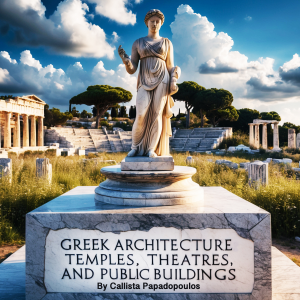

Greek Architecture
Callista Papadopoulos
This audiobook is narrated by a digital voice.
The architectural legacy of ancient Greece emerged from a complex synthesis of indigenous traditions, foreign influences, and innovative responses to the unique geographical and cultural conditions of the Aegean world, ultimately creating a system of design principles and aesthetic values that would influence building practices throughout the Western world for over two millennia. The development of Greek architecture cannot be understood merely as a linear progression of stylistic evolution but rather as a dynamic process of cultural adaptation and artistic experimentation that reflected the broader social, political, and religious transformations that characterized Greek civilization from its earliest emergence through its classical flowering.
The geographical environment of Greece profoundly shaped the development of its architectural traditions, as the mountainous terrain, scattered islands, and limited agricultural resources created conditions that favored the development of small, independent communities rather than large centralized kingdoms. This political fragmentation encouraged architectural diversity and innovation, as each city-state developed its own building traditions while participating in broader cultural exchanges that spread new techniques and ideas throughout the Greek world. The abundance of high-quality stone, particularly marble, limestone, and volcanic rock, provided Greek builders with materials that enabled both monumental construction and refined decorative work that achieved unprecedented levels of artistic sophistication.
Duration - 49m.
Author - Callista Papadopoulos.
Narrator - Digital Voice Archie G.
Published Date - Sunday, 26 January 2025.
Copyright - © 2025 Callista Papadopoulos ©.
Location:
United States
Networks:
Callista Papadopoulos
Digital Voice Archie G
Ron Carver LLC
English Audiobooks
INAudio Audiobooks
Description:
This audiobook is narrated by a digital voice. The architectural legacy of ancient Greece emerged from a complex synthesis of indigenous traditions, foreign influences, and innovative responses to the unique geographical and cultural conditions of the Aegean world, ultimately creating a system of design principles and aesthetic values that would influence building practices throughout the Western world for over two millennia. The development of Greek architecture cannot be understood merely as a linear progression of stylistic evolution but rather as a dynamic process of cultural adaptation and artistic experimentation that reflected the broader social, political, and religious transformations that characterized Greek civilization from its earliest emergence through its classical flowering. The geographical environment of Greece profoundly shaped the development of its architectural traditions, as the mountainous terrain, scattered islands, and limited agricultural resources created conditions that favored the development of small, independent communities rather than large centralized kingdoms. This political fragmentation encouraged architectural diversity and innovation, as each city-state developed its own building traditions while participating in broader cultural exchanges that spread new techniques and ideas throughout the Greek world. The abundance of high-quality stone, particularly marble, limestone, and volcanic rock, provided Greek builders with materials that enabled both monumental construction and refined decorative work that achieved unprecedented levels of artistic sophistication. Duration - 49m. Author - Callista Papadopoulos. Narrator - Digital Voice Archie G. Published Date - Sunday, 26 January 2025. Copyright - © 2025 Callista Papadopoulos ©.
Language:
English
Greek Architecture
Duration:00:49:40